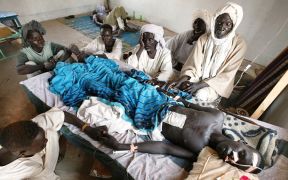FEATURE-How many have died in Darfur?
By Russell Smith, BBC News
Nobody knows how many people have died during the two-year conflict in Sudan’s western Darfur region.
Feb 16, 2005 — But the widely quoted United Nations figure of 70,000 is clearly wrong, because it was based on a study that does not include those killed in the violence and just covers a six-month period.

|
|
An internally displaced person in South Darfur is treated for a bullet wound to his chest after being shot by Janjaweed militia. His family members surround him in a hospital in South Darfur, October 2004. (HRW). |
The UN says that more than two million of the estimated six million population have fled their homes, but the organisation is reluctant to suggest how many might have died in total.
Some analysts are estimating that the true death toll could be four or five times higher than the 70,000 figure.
One significant problem in establishing a clear idea is that the Sudanese government and their allies, an Arab militia known as the Janjaweed, are blamed for most of the deaths, so the Khartoum authorities show little interest in encouraging any accurate assessment. Indeed they consistently underplay the scale of the crisis.
Myriad international differences on Darfur have also contributed. The UN Security Council remains unable to agree on how to sanction the government or the perpetrators of abuses from all sides. The small African Union force meant to monitor a ceasefire is ineffective and under strength.
This has led to continuing clashes, meaning many parts of the province remain insecure and inaccessible to those who might investigate.
A recent UN mission visited to establish whether US claims of genocide in Darfur were accurate. It failed to give any kind of toll, despite cataloguing hundreds of violent incidents and many eyewitness accounts of village massacres.
The commission concluded that grave human rights abuses were taking place but there was no genocide. It is calling for war crimes trials.
Studies
Given the lack of clarity and sensitivities for agencies working in Sudan, there has been speculation and extrapolations from researchers outside Sudan about how many might have died in Darfur.
The calculation has been to guess how many might have died in violence based on eyewitness accounts – and then add on those that could have died from other causes over and above those that would normally have died in this harsh and sporadically violent part of the world.
This has led to claims that several hundred thousand may have died.
The only major study of deaths in Darfur so far has been conducted by the UN’s World Health Organisation which estimated that as many as 70,000 people had died of disease and malnutrition caused by the conflict between March and October 2004.
Senior WHO official Dr David Nabarro told BBC News that they are to conduct a new mortality survey in March to establish whether, as he suspects, mortality rates have fallen.
“Since the end of the rainy season, relief supplies have improved dramatically and sickness figures have been falling”.
He says that many groups took their figures out of context and twisted them.
“Numbers are always difficult – but what is so unusual is that there is so much interest.”
Sums
The 70,000 figure covered the worst period, before aid agencies were given greater access to Darfur. The number of deaths in the camps has now fallen, but either side of the six-month period there will still have been substantial deaths, campaigners say.
Added to this, is a figure for how many may have been killed in the violence.
Amnesty International’s best estimate for how many may have died from violence since the conflict began – which took account of attacks on hundreds of villages – is 50,000.
The UN’s emergency relief coordinator Jan Egeland has admitted the total death toll in Darfur could be much higher than the 70,000 WHO figure but says he does not know.
US academic Eric Reeves estimates the figure at 340,000 at the beginning of 2005.
UK-based Dr Jan Coebergh, who once worked in Darfur, has examined a range of aid agency health surveys. He puts the figures slightly lower at about 300,000 – but he admits it is little more than a stab in the dark.
“We don’t know enough about how many people are dying from violence let alone natural causes in inaccessible areas.”
“The reality is that we just don’t know the scale of the problem,” Dr Coebergh told BBC News.
Protests
Amnesty’s Sudan researcher Elizabeth Hodgkins says that as a protest against the unwillingness of the government to compile numbers they began putting together lists of those killed.
They presented several thousand names to the UN genocide commission – in a 54-page document.
“We wanted to put names to the victims – otherwise it just becomes a faceless statistic,” she told BBC News.
Julie Flint, the author of a human rights watch report and well known writer and campaigner on Sudan, says that any statistics can only give a partial figure, as they tend not to include deaths during the first year of the conflict, or from among the large numbers of people in hiding – of which little is known.
But she says the critical thing is for Khartoum to change its approach to prevent future deaths.
“The government launched a massive attack in Darfur just as they were in Abuja for the last round of peace talks with the rebels reaffirming their commitment to a ceasefire.”
“The important thing is that the deaths stop. How many more will die while the international community argue?”
